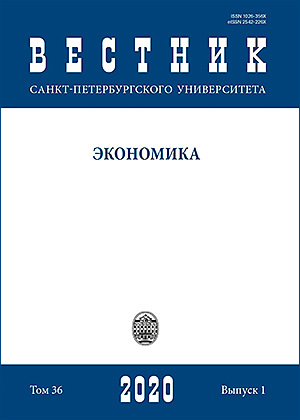Environmentally Oriented Financial Sustainable Growth. Case of JSC “Gazprom”.
Abstract
The Paper investigates why financial policies and the sustainable growth objectives established by some companies are mutually controversial, and to explore the options open to companies for remedying this worsening problem. Authors explore the Russian biggest gas company Gazprom financial growth sustainability. Unlike traditional interpretations, we consider financial sustainability as the result of interaction and interconnection between finance, energy, environmental, and social subsystems (F-E-Env-S). We analyze the relationship transversality between the subsystem indicators using Sustainable Financial Growth Index (FSI) and forecasting modeling until 2030. Research results show that Gazprom’ financial sustainable growth system disrupted, we offer ways to prevent the development of such barriers. This paper presents an approach using Shannon’s negentropy to improve the discrimination of data envelopment analysis (DEA) sustainable system models. In this approach, DEA efficiencies are first calculated for all possible variable subsets and analyzed using Shannon’s entropy theory to calculate the degree of the importance of each subset in the Gazprom sustainable growth system. Then, we combine the obtained efficiencies and the degrees of importance to generate an overall efficiency score (CES), which can observably improve the discrimination of Gazprom Sustainable System Efficiency DEA models.
Keywords:
Environmental Finance, Financial Sustainable Growth Index (FSI), social-energy-environmental factors affecting on financial sustainable growth, data envelopment analysis (DEA), Shannon’s entropy., Зеленые финансы, индекс устойчивого финансового роста, социальные, энргетические и экологические факторы, влияющие на финансовый устойчивый рост, DEA- анализ, энтропия Шеннона.
Downloads
References
Burtonshaw-Gunn, S. a. and Salameh, M. (2009) ‘Change Management and Organizational Development Developments in Change’, Essential Tools for Organisational Performance: Tools, Models and Approaches for Managers and Consultants, pp. 17–50. Available at: www.essentialtoolsseries.com/.../userfiles/estools/.../Chapter 2.pdf.
Chakrabarti, C. G. and Chakrabarty, I. (2007) ‘Boltzmann Entropy : Probability and Information’, Entropy, 52(1), pp. 5–7. Available at: http://arxiv.org/abs/0705.2850.
Chen, Y. and Li, C. (2011) ‘Entropy, Substitution and Sustainable Economic Growth’, Research in World Economy, 2(2), p. p66. doi: 10.5430/rwe.v2n2p66.
Daly (2005) ‘Eocnomics in a Full World’, Scientific American, 293(3), pp. 100–107. doi: 10.1038/scientificamerican0905-100.
Daly and Farley (2004) Ecological economics: principles and applications, Ecological Economics. doi: 10.1017/CBO9781107415324.004.
Daly, H. E. (2007) ‘Ecological Economics and Sustainable Development, Selected Essays of’.
Emrouznejad, A. et al. (2016) ‘Data Envelopment Analysis and its Applications’, Proceedings of the 13th International Conference on Data Envelopment Analysis, (August 2015), pp. 1–203. doi: 10.13140/RG.2.1.4082.9202/2.
ESRF (2017) ‘Energy Strategy of the Russian Federation till 2035’.
Friedman et al. (2017) ‘Lasso and elastic-net regularized generalized linear models. R Package Version 2.0-13’.
Gazprom (2017) ‘Gazprom Annual Statement, Financial statement, Sustainability statement, Environmental Statement 2005-2016y.y.’ Available at: http://www.gazprom.com/.
Gazprom (2018) Gazprom’ Policy in the Energy Efficiency and Energy Savings area.
Georgescu-Roegen (2013) ‘AND ECONOMIC ENERGY MYTHS (reprinted from Source Southern Economic Journal, Vol. 41, No 3 (Jan. 1975), pp.347-381)’, 41(3), pp. 347–381.
Green, M. J. and Georgescu-Roegen, N. (1973) ‘The Entropy Law and the Economic Process.’, The Economic Journal, 83(330), p. 551. doi: 10.2307/2231206.
Hall, C. and Klitgaard, K. (2014) Energy and the Wealth of Nations, Springer. doi: 10.1007/978-1-4419-9398-4.
Higgins, R. (1977) ‘How much growth can a firm afford?’, Financial Management, 6(3), pp. 7–16. doi: 10.2307/3665251.
International Energy Agency (2015) World Energy Outlook 2015. Available at: http://www.worldenergyoutlook.org/media/weowebsite/2008-1994/WEO2006.pdf.
Ivashkovskaya (2014a) ‘Does corporate financial architecture contribute to sustainable corporate growth? The evidence from Russian companies.’, 4(32), pp. 11–33.
Ivashkovskaya (2014b) ‘Does corporate Financial Architecture contribute to sustainable corporate growth? The evidence from Russian companies. Journal of Corporate Finance Research.’, Journal of Corporate Financial Research, 32(4), pp. 11–33.
Kleiner (2015) ‘Sustainability of Russian economics in the System Economic Theory aspects (in Russian)’, (12).
Kleiner, G. . b and Rybachuk, M. . c (2016) ‘System structure of the economy: Qualitative time-space analysis’, Fronteiras, 5(2), pp. 61–81. doi: 10.21664/2238-8869.2016v5i2.p61-81.
Li, X. (2015) ‘Fuzzy cross-entropy’, Journal of Uncertainty Analysis and Applications, 3(1), p. 2. doi: 10.1186/s40467-015-0029-5.
Munoz-Alicea, R. (2011) ‘Introduction to Bifurcations and The Hopf Bifurcation Theorem for Planar Systems’, p. 11.
Pascale, A. DE (2012) ‘Role of Entropy in Sustainable Economic Growth’, International Journal if Academic Research in Accounting, Finance and Management Sciences, 2(1), pp. 293–301.
Sarker, D. M. O. F. (2014) ‘Python Network Programming’, (C), p. 234. Available at: http://it-ebooks.info/book/3515.
Scellato (2013) ‘NetworkX : Network Analysis with Python Today ’ s Outline’, (February), pp. 1–51.
Tibshirani (1996) ‘Regression Shrinkage and selection via the Lasso’, Journal of the Royal Statistical Society. Series (B) (Methodological), 58(1), pp. 267–288. doi: 10.1099/mic.0.27954-0.
U.S. Energy Information Administration (2016) International Energy Outlook 2016, International Energy Outlook 2016. doi: www.eia.gov/forecasts/ieo/pdf/0484(2016).pdf.
University of Michigan Coursera (2018) ‘Applied Social Network Analysis in Python’, Coursera. Available at: https://www.coursera.org/learn/python-social-network-analysis/lecture/ZhNvi/clustering-coefficient.
Published
How to Cite
Issue
Section
License
Articles of the St Petersburg University Journal of Economic Studies are open access distributed under the terms of the License Agreement with Saint Petersburg State University, which permits to the authors unrestricted distribution and self-archiving free of charge.






